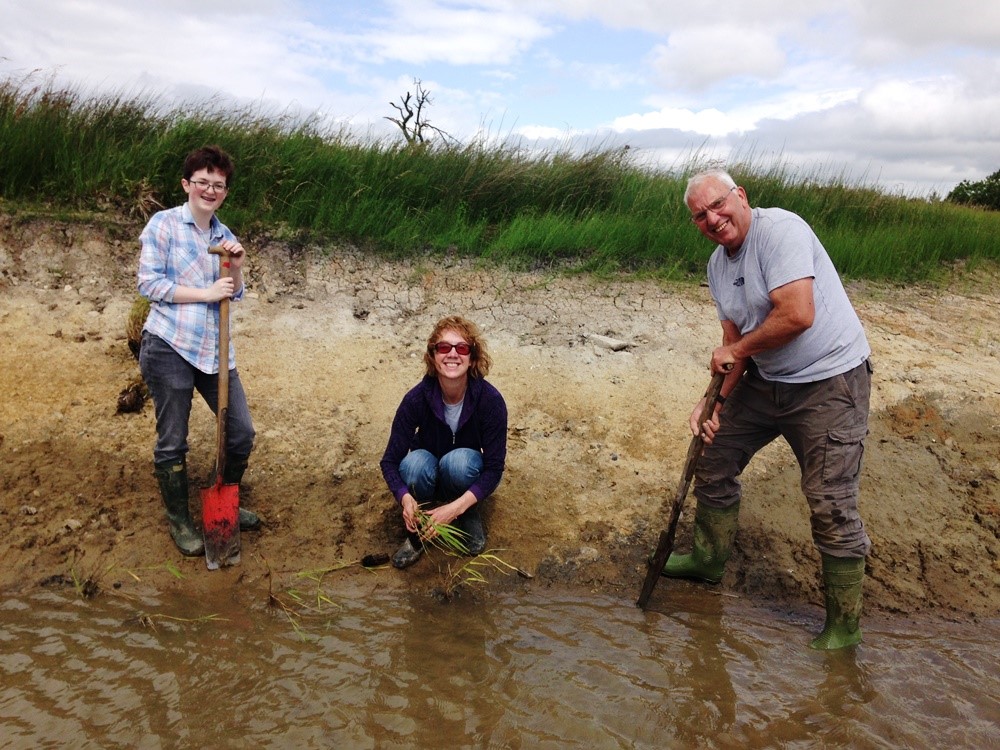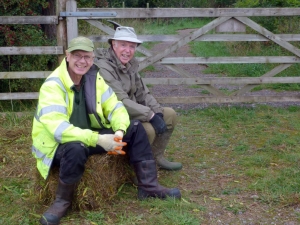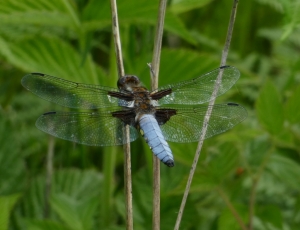Blog Archive (25) Posts Made in September 2018
A Busy Wednesday
Sunday, September 30th 2018
There were no moths to ID as the wind speed was set too high on Tuesday evening. Fingers crossed for this Tuesday. So we made a start on filing the photos from various displays. These are organised into the main groups, each with its own box file, then each species has its own folder, labelled.

Each photograph is identified. Some are easy to do others require a little more investigation.
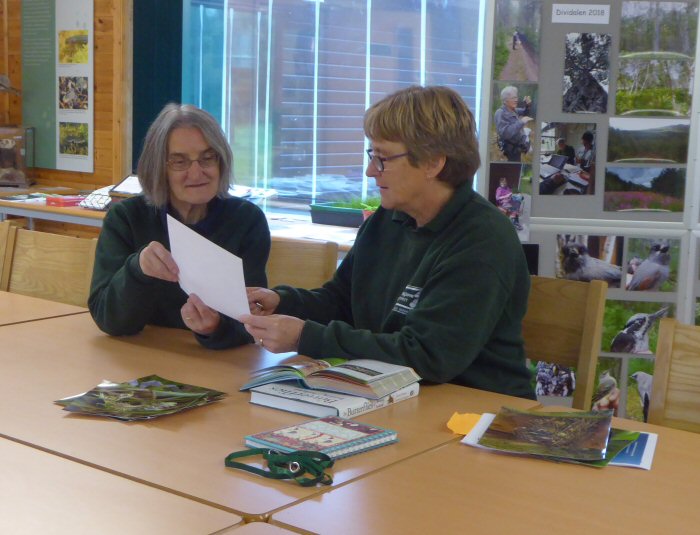
This task was soon completed and we set out on the flower walk. Last year we recorded 53 flowers, this year only 26. Red Clover, Tormentil and Fairy Flax were growing on the middle moor, along with Eyebright.

As we walked past Lark and Taurus we noticed that they were becoming 'fuffy' due to their winter coats growing.

As flowers were far and few between we did get waylaid looking at fungi. In the area between the Scots Pine and the ditch on the middle moor we found Yellow Club growing. This is recorded on the species list but not in this area.

Usually Willows turn yellow brown in autumn and do not jump out at you as being colourful, but this one had a definite red and orange, almost gold tinge to it.

The bright orange covered seeds are starting to burst from the pink fruit on the Spindle trees.

These Hazel nuts have so far escaped the eyes of Grey Squirrels and Jays.
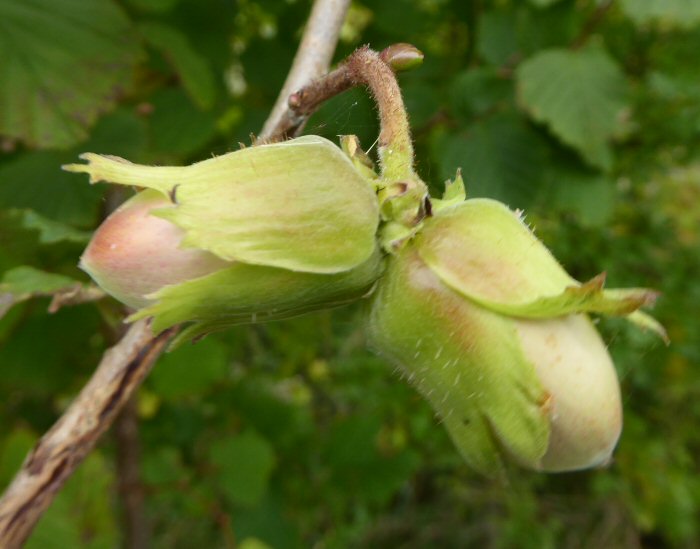
Thank you to all the volunteers involved in the various activities.
Upcoming Events
Friday, September 28th 2018
I thought it best to let you all know about upcoming events here at Foxglove, with the most pressing being next Wednesday's (3rd) 'Owl Pellet Discovery for Adults'.
.jpg)
An owl pellet is the regurgitated indigestible parts of an owl's diet, such as fur and bone. By analysing these regurgitated pellets we are able to find out quite a bit about an owl's lifestyle.
Since most of the prey's bones are not actually broken during the attack and the subsequent digestion process, they can be readily identified in the pellet. Most pellets include a skull or skulls, which makes identification of the prey relatively simple.
.jpg)
As if this wasn't enough we also have the first 'Winter Worky Day' of the 2018/19 season on Saturday 6th October! Practical work is likely to centre about clearing and tidying up in the woodland, or removing reed mace from the Wetland Ponds.
Here is our updated What's On list for the coming months…


If you are interested in attending any of these events please let the Reserve Managers know via the website or by calling 01748 830045 or 07754 270980.
Woodland Work
Thursday, September 27th 2018
Still working on storm damaged trees today, this huge Ash limb down by the Lake required careful disassembly to ensure that the job could be completed in a timed, safe and controlled manner.
.jpg)
Thankfully I had two happy helpers to ease the burden of moving the cut logs and brash, otherwise it may have proved to be a full day job!
.jpg)
Afternoon work continued on from the work carried out by Risedale Sports & Community College in the woodland over the other side of Risedale Beck. Between me and Christine we managed to down three hung up trees and process the timber ready for next week.
.jpg)
Risedale Rangers
Wednesday, September 26th 2018
We're still tidying up from recent storms and high winds here at Foxglove; thankfully I was able to call on the kids from Risedale Sports & Community College to help me.
.jpg)
We started the day by taking a walk to see the Owl and Bat Box that the college have adopted as part of our Adopt-A-Box Scheme and quickly moved on to gathering fallen debris into habitat piles and piles ready for burning.
.jpg)
Some of the branches were quite formidable, such as this Ash limb that the group were working on just before lunch.
Foxglove has many veteran Ash trees that are monitored regularly for signs of Ash Dieback caused by the fungi Hymenoscyphus fraxineus. The fungus causes leaf loss, crown dieback and bark lesions in affected trees and once infected is usually fatal, either directly, or indirectly by weakening the tree to the point where it succumbs more readily to attacks by other pests or pathogens.
Thankfully some ash trees seem able to tolerate or resist infection, and scientists are studying the genetic factors which make this possible so that tolerant ash trees can be bred for the future.
The Madness of Sheep
Tuesday, September 25th 2018
Removal of sheep from the Reserve seems to becoming a weekly task!
This time 14 managed to find their way onto the Reserve and quickly disappeared into the Willow Carr maze that is Foxglove. After some time we found them; they had made their way from the Secret Heath to the Hay Meadow where they were happily munching on the sward a few weeks ahead of schedule.

After all the madness with the sheep we started on repairing the straining post on the Wetland, which required the digging of a humongous hole along with the use of the quad bike to alleviate wire tension.


After getting the straining post set in we busied ourselves with alleviating more tension on the post so that we were able to slip the existing struts into position (this time higher up to give additional support for the load-bearing post).

After the excitement of the day it was worth taking a moment to admire the Moorland from the top gate before turning the quad bike in for the day.

Flowers, Fruits and Seeds
Sunday, September 23rd 2018
In June we marvel at the bright yellow of Yellow Flag Iris in the Scrapes and around the lake.
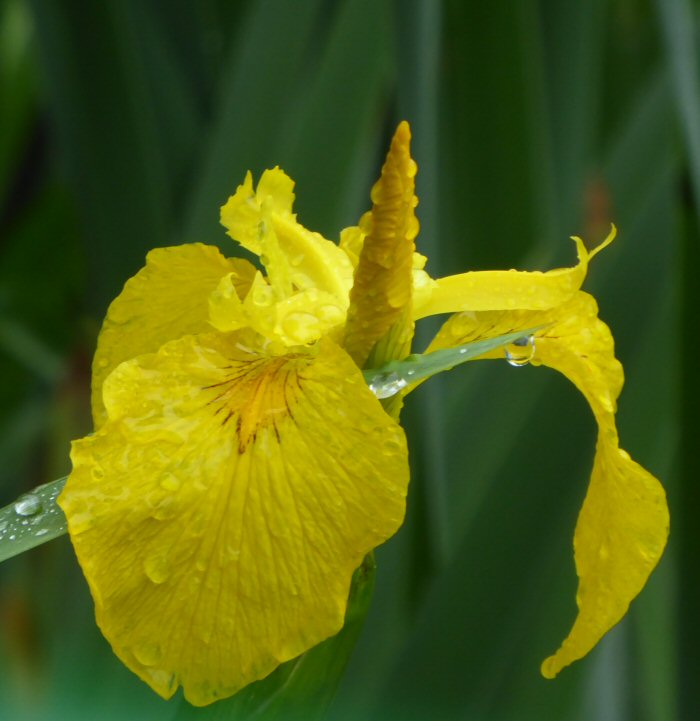
Unfortunately these flowers do not last long and soon go over. All we can see for several weeks are the long flat leaves. By September the seed pods have developed. They have a very tough outer coat, protecting the yellow orange seeds inside. As the seeds ripen so the pod breaks open exposing the seeds which are then dispersed by the stem gently moving in the wind.

Blackthorn flowers early and soon coats parts of the reserve white with blossom.

Green leaves soon cover the black stems and by autumn the blue Sloes have developed. This year has been a particularly good year and branches are hanging with berries.
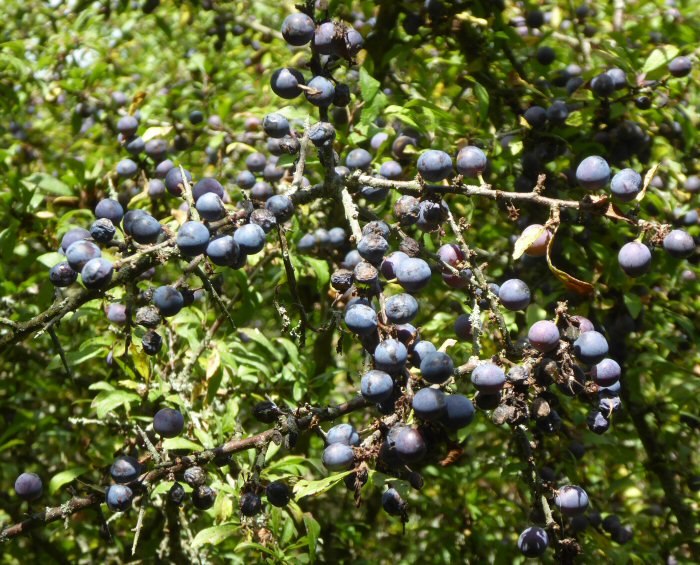
May sees us able to 'cast a clout', although some layers are still left handy for cold mornings. Hawthorn blossom follows the Blackthorn covering different areas of the reserve white.
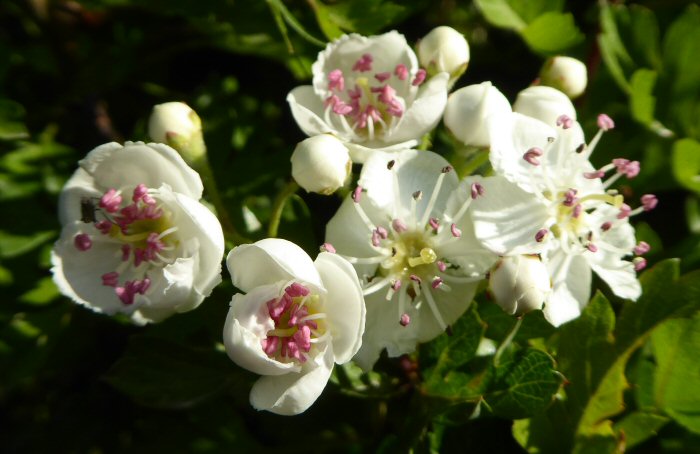
Now those same trees are full of red berries just waiting for our winter migrants to return.
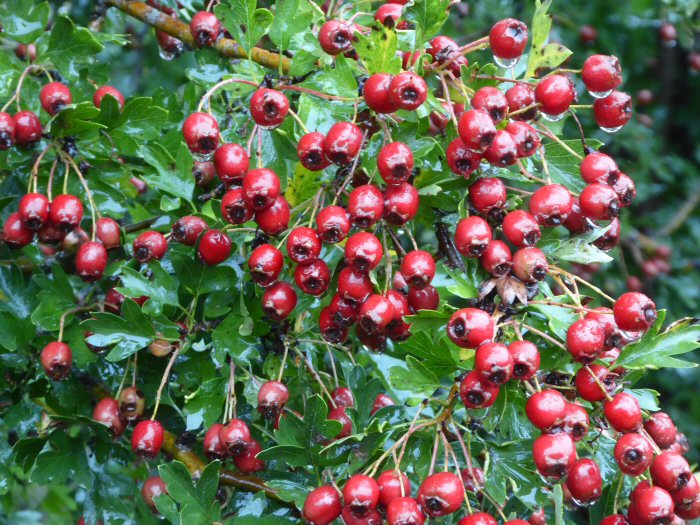
Hemp Agrimony is not the most attractive of flowers to look at, but appeals to many butterflies, bees and hoverflies as it is nectar rich.

The seed heads are delilcate and the seeds dispersed by gentle breezes.

Interesting Creatures
Saturday, September 22nd 2018
Whilst out pond dipping, looking for caddis larvae in their cases, I caught, what initially I thought was a very thin Pond Skater! The grey cells began to work and I realised that it was a Water Measurer. These invertebrates are like the Whirligig Beetles, Pond Skaters and Water Crickets all having hydrophobic hairs on their undersides and or legs. The repulsive force between the water and these hairs is sufficient to keep the creatures on the surface.
Pond Skaters are quite robust and if there is fly on the water surface they move very quickly to attack it. Water Measurers tend to live up to their name and it looks like they are measuring each step carefully.
These were first recorded on the species list in August 2008 and then again in September 2017.

Several shield bugs have been found on our explorations around the reserve. We were unsure of the ID of this one until we looked closely and found that it was hairy! It is a Hairy Shield Bug. Even its antennae have hairs! This is a new species for the reserve. It is also known as the Sloe Bug, as Blackthorn is one of its food plants.
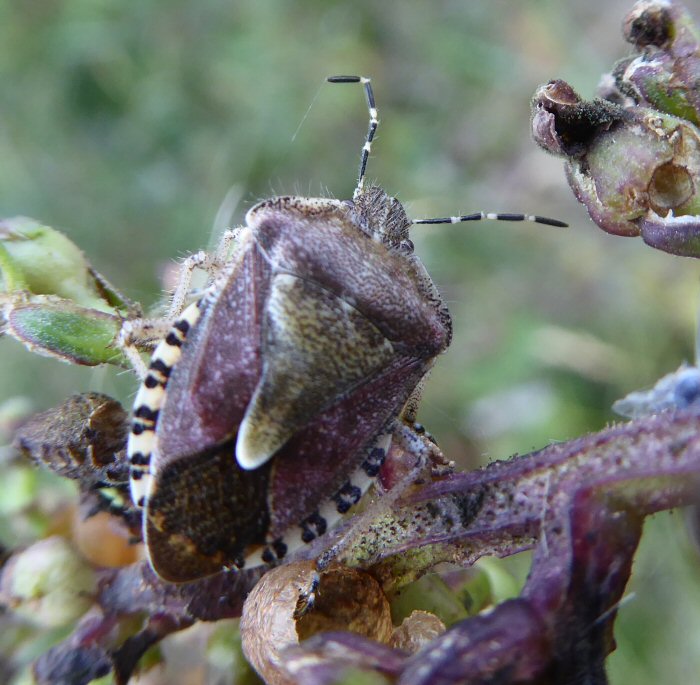
A close up of its hairs.

Another insect that we have recently identified is Woolly Alder Sawfly larva. Only one record in July 2016.
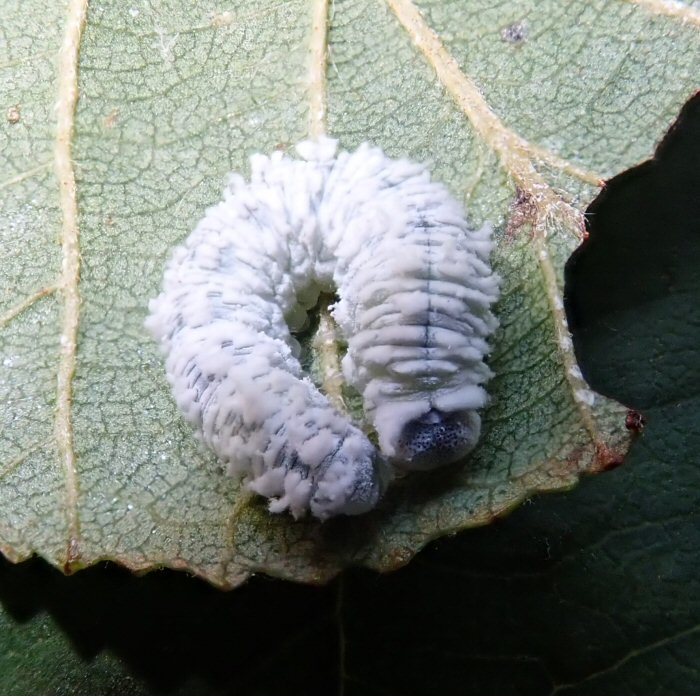
Many Pond Mud Snails
Friday, September 21st 2018
We now have well over 100 individual Pond Mud Snails (Omphiscola glabra) in one of our tanks in the Field Centre Activity Room.

These small snails live in temporary freshwater habitats, and are found in the ponds of the Reserve's Wetland. Once widespread, these little Molluscs are now classified as Vulnerable by the Joint Nature Conservation Committee.
On other news we have had a delivery of timber from Fall Timber of Bedale; amongst the order were new waymarker posts, decking boards, and fencing materials, all of which will prove very useful over the coming months as we repair and replace structures before winter takes a hold of the place.

Aside from the timber we ordered the guys over at Fall Timber also dropped off a large stack of offcuts; all of which will be very useful for future bird box making events.

Storm Ali visits Foxglove
Thursday, September 20th 2018
We have spent most of our day clearing up after Storm Ali, which has left a trail of twigs, branches and trunks strune across tracks and trails all over the Reserve.

In the late afternoon we moved onto owl box repair, before affixing plaques to the trees housing boxes adopted by Risedale School.

Risedale School have adopted one Tawny Owl and one Bat box for the coming calendar year as part of Foxglove's Adopt-A-Box Scheme. Adopting one of the boxes on the Reserve raises funds for conservation efforts and is a neat way of keeping in touch with the amazing animals that frequent them.

Just a Tad Windy!
Wednesday, September 19th 2018
With the forecast being for Storm Ali to arrive today with predicted gusts up to 60 mph, it was decided to move Lark and Turus from the Wetland. While this still has plenty of vegetation for them to eat, there is little shelter from south-westerly winds, so the gate was opened to Plovers Pool and they happily took themselves in there, no doubt encouraged by the signs of fresh growth.

Our visitors today included our regular group from Risedale School who come on a regular basis ion Wednesdays. Last week we had intended to get round to re-staking some trees where the stake had broken, but we spent last week checking how some of the tree planting from last year was doing so it was done today.
They also checked and filled some of the feed hoppers and then started work on helping to bring in poles from some of the net rides that will not be used over the coming months. They carried on working as the wind got ever stronger and in a very heavy downpour, so many thanks to all of them for their efforts.
Meanwhile later in the day as the wind had strengthened to its maximum, a quick check on the ponies showed them with their hind quarters tucked into the shelter from the Gorse bushes on the Training Area side of the boundary fence and happy to be out of the worst of the wind.
Two Jobs Well Done
Tuesday, September 18th 2018
Following on from yesterday, and given the rain this morning, the Tuesday volunteer group set about bagging up the chaff in the Workshop so that it could be taken down to the Seed Store once the rain had stopped. The new white woven bags have proved a real bonus and have made the whole job a lot easier.
The initial aim was to fill enough for a couple of trailer loads to be taken down. However, the rain cleared quicker than forecast so it was logical to take the first load down and, by the time the quad bike and trailer were back at the Workshop, another set of bags was ready to be loaded on.
By the end of the morning over 40 bags had been filled, transported and stacked in the Seed Store, so very much a job well done with the chaff in dry conditions and the Workshop is clear again. We obviously missed a little bit as there was a Field Vole busily picking through some chaff on the floor when we got back.
In the afternoon the team made their way over to the steps on the Green Route in the Risedale Beck Conifer Woodland. Rotting wood was stripped from the steps here and replaced with new lengths of timber and then the steps were back-filled. A good job well done again, so thanks to John, Peter, Eddie, Brian and Colin for their hard work today.
Chaff and Chaffinches
Monday, September 17th 2018
One of the first things this morning that stood out was just how much the Red Oak next to the Field Centre had increased its autumnal colour over the last few days. Even in poor light and drizzle, it certainly stood out against the background of green Willow leaves.
After checking to see how Lark and Taurus were doing, the first part of the morning was spent inspecting inlets to ponds, bird hides, Mink traps and Mink rafts - the normal routine on a Monday morning. With the arrival of some new bags, we can now crack on with bagging the chaff delivered just over a week ago and get it taken down to the main Seed Store . The new bags are slightly bigger than the other ones we use, so it didn't take long to fill the trailer.
This was then taken down to the store this afternoon where the bags were stacked, keeping all of this year's bags on the left hand side. The bags stacked against the right wall are the remnants of the delivery from last year. Someone asked what we do with this, and so they went round with me to check bird feeders and the hoppers, which were filled by Michelle, one of our weekend Managers, over the last two days. These are ideal for birds that are not so happy using the feeders and are particularly liked by Bullfinches and Chaffinches as they provide seed and some shelter at the same time.
Despite the drizzle, we have had a few visitors today including two ladies who, despite living in Bedale for the last 20 years, had never been to Foxglove before. Another couple spent time watching the birds on the feeders in the Field Centre garden, marvelling at how quickly they disappeared when a Sparrowhawk dashed through. Had they been there a little later, they would have seen the male bird return but this tiime successfully as it managed to take a young Chaffinch that had come out from the shelter of the hopper.
Hidden Away
Sunday, September 16th 2018
Something pink caught my eye, just where it should not be. It was a Devil's Bit Scabious, pink instead of purple.

Something else pink was hiding away, a Foxglove. We usually find at least one in flower this late in the season.

Red Campion flowers in the Scrapes and over the last couple of years in some other places too. It flowers early and sets seed quickly. However along Risedale Beck some can still be seen.
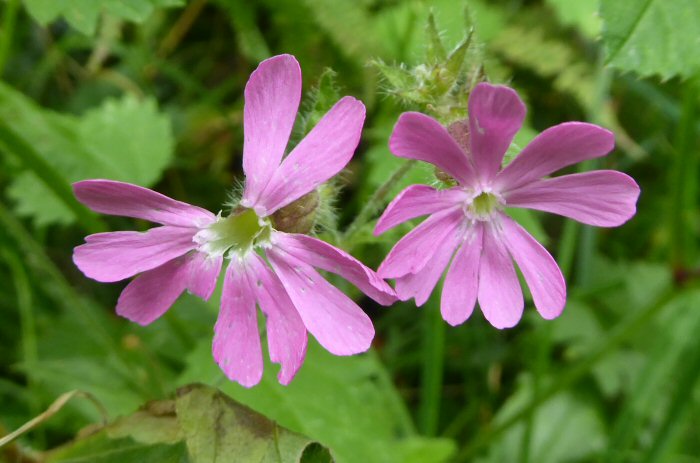
Red is a colour associated with autumn and these Blackberry leaves certainly were red.
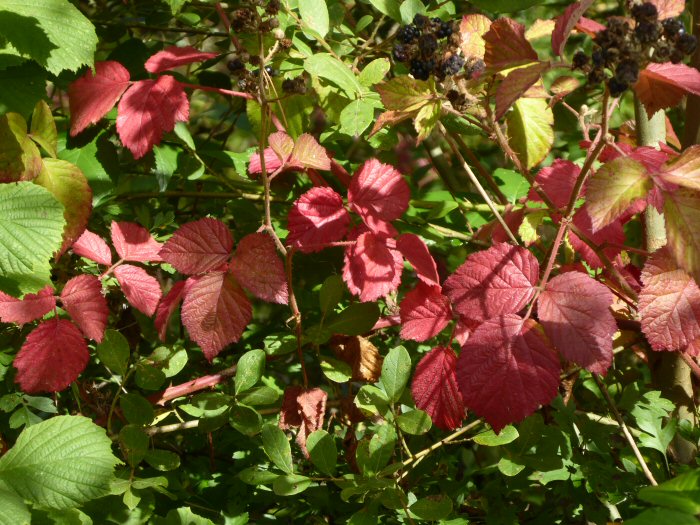
Autumn sees a decrease in the number of flowers but, if the conditions are right, warm and damp, then the fungi begin to appear. At the minute it does require a little more dampness, in other words - rain, but some fungi are beginning to develop their fruting bodies. Puff Balls are growing in the woodland.

I don't know the name of this fungi and am not even sure if this is what it should look like or if it has been fancily chewed around its edges, but I did think that it looked attractive.
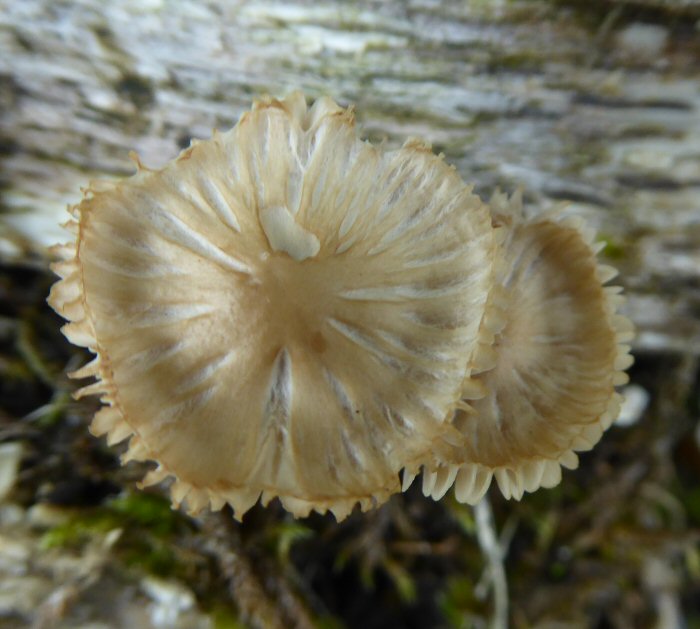
If you are interested in finding out more about the fungi at Foxglove then there is a Fungal Foray on Wednesday 17th October. More details on the Events page.
Looking at the forecast for the next ten days it is unlikely that there will be a visit to the Crater. The wind speed is just too great. There was a lull yesterday and in almost perfect conditons some of the bird ringers raised the nets. The Mipits are still arriving and 122 were ringed, along with a Goldfinch and nine Reed Buntings. It was a good morning. Thank you to everyone who helped.

Amazing Nature
Saturday, September 15th 2018
On Wednesday we were thrilled to find a rather large Buff Tip caterpillar chewing away on Willow leaves. Today I wondered if it would still be around, but decided that it would probably have disappeared. How wrong I was. It was still there and still chewing away! I was able to get a close up and you can see how hairy it is and also the dark circles that are the spiracles, through which it breathes.

Out on the moor the Willow shrubs did not hold as many inverts as Wednesday, but did have another large caterpillar, as yet unidentified.

In the sunny sheltered spots a Common Darter was sunbathing.

Some were not quite as lucky. One sitting on the handrail did a double somersault as the wind caught its abdomen and wings. It was not bothered at all, as it flew around, landed and hung on tightly.
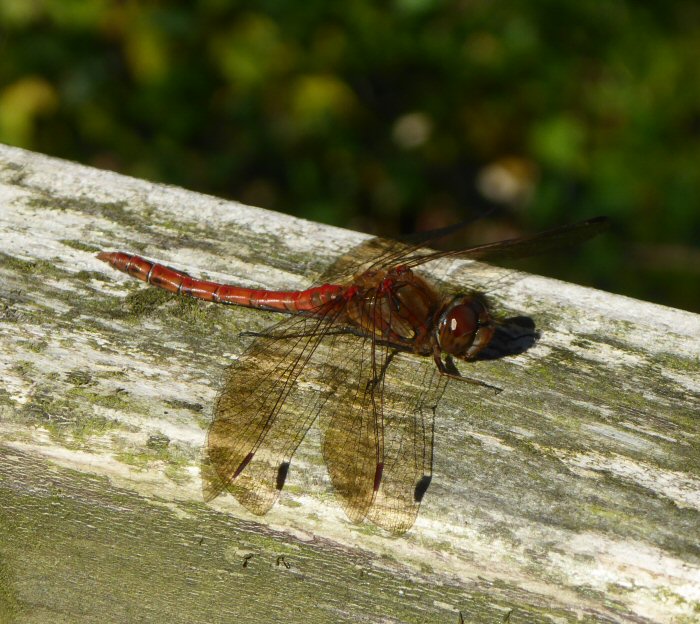
Blackberries are in fruit, providing food for birds, small mammals and snails. It must have had an interesting journey to reach its goal.

Sometimes something just catches your eye. This spider had spun its web between two Wild Angelica seed heads and although not covered in dew, the web was clear.

A Lot of Rot Can Be a Good Thing…or Not!
Friday, September 14th 2018
Part of the checks taking place on the reserve are on some of the older Ash trees in the semi-natural woodland area of Risedale Beck. There are some trees in this woodland corridor which are veterans and show how trees cope with rotting hardwood. The Ash tree below is one that has featured on the blog before but we got a surprise when checking this one.


Deep in the recesses of the hollow bole of the tree we detected movement. Initially we thought it might be a mouse or vole, but once we shone a light in there it became clear that a Toad had taken up residence. Conditions here would be ideal for an amphibian with it being cool and damp and a plentiful supply of food.

Not so good was finding the sudden surge in fruiting bodies on this rotting stump further along the beck. These look like Honey Fungus which is one that can cause severe rot in trees and which may contribute to the problems caused by the Ash Dieback disease.
Cutting the Orchid Ride
Thursday, September 13th 2018
Today we have been cutting and clearing a Woodland Ride that runs parallel with the Access Road and is bordered by a row of veteran Ash trees.

The area is awash with Early Purple Orchids, which will emerge as early as January, being one of the first Orchids to flower in Spring. As such it is important to remove the cut vegetation so as to reduce the fertility of the soil and the amount of competitive grass species in the sward.

Aside from Meadow and Ride management we had to take time out to round up and move two escapees that had found their way onto the Scrapes. Both were moved to the Moorland, before being taken away from the Reserve and onto pastures familiar.

Meet the Moths!
Wednesday, September 12th 2018
We had a good group in today for Foxglove's 'Meet the Moths!' event. Thankfully moths were caught in the trap despite last night's weather.

Amongst the magnificent moths caught in the trap was this Canary-shouldered Thorn, whose larvae feed on a variety of deciduous trees, and which flies from July to October.
We also had this Silver Y, complete with the very distinctive Y-shaped patterning from which it got its name. A very common UK immigrant, the caterpillar of this moth feed on a wide range of low-growing plants, including bedstraws (Galium sp.), Clovers (Trifolium sp.), Common Nettle (Urtica dioica), Garden Pea (Pisum sativum) and Cabbage (Brassica oleracea).
On a walk around the site a Buff-tip caterpillar was spotted munching away on Willow…
And keeping with Lepidopteran news, the Reserve has been inundated with Speckled Wood butterflies.
The Path Works Continue
Tuesday, September 11th 2018
We've now finished laying aggregate path from the Field Centre down to the start of the boardwalk on the Scrapes, some 118 meters of path.

Afterwards we moved onto more path works, continuing on from what we started a little while ago on the Green Route by the perimeter fence and steps. We've now finshed over 50 meters on this section, with a further 40 meters left to finish off.

Birds and Insects
Sunday, September 9th 2018
Last week the bird ringers visited the Crater. We watched the sun rise but it made little difference to the temperature and everyone was well wrapped up.
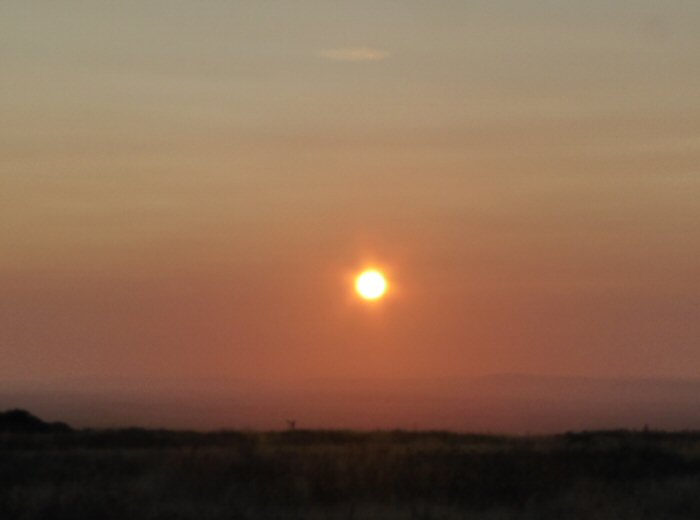
Nearly 100 birds were ringed, most of them were Meadow Pipits.

On 'Top of the World' you can look down to the wetland of Foxglove.
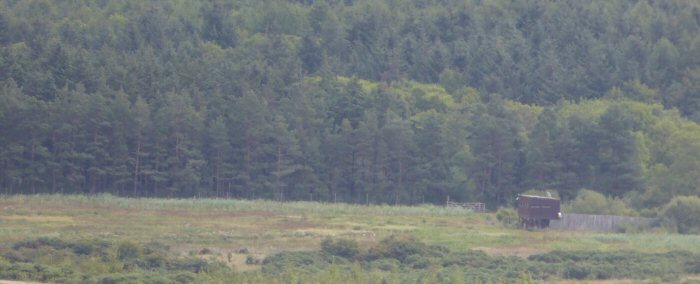
Unfortunately the weather has not been kind to allow us to go back to the Crater. It needs to be still and dry.
When the sun does come out the temperature rises and the butterfliles come out to feed. In the centre of the reserve they can be found on Hemp Agrimony. Out on the moor Water Mint is in flower and we counted seven Small Tortoiseshells and two Painted Lady butterlies in one small area.
Painted Lady Butterflies are migrants, usually only visiting us during a very warm summer.

Small Tortoiseshells have done very well this year after a poor one last year, when we saw only one or two.

Kidney Spot Ladybirds live on Ash trees at Kidney Spot Corner. Just to confuse us they have been seen on Willow near the Field Centre. We were really pleased to find them back at Kidney Spot Corner but then noticed that one was rather small. Photographs were taken and the ID was confirmed that it was a Heather Ladybird. Only two sightings have been recorded once in 2013 and again in 2014. Their habitats do include Heather, which is their host plant, and conifers. They hibernate in bark crevices.
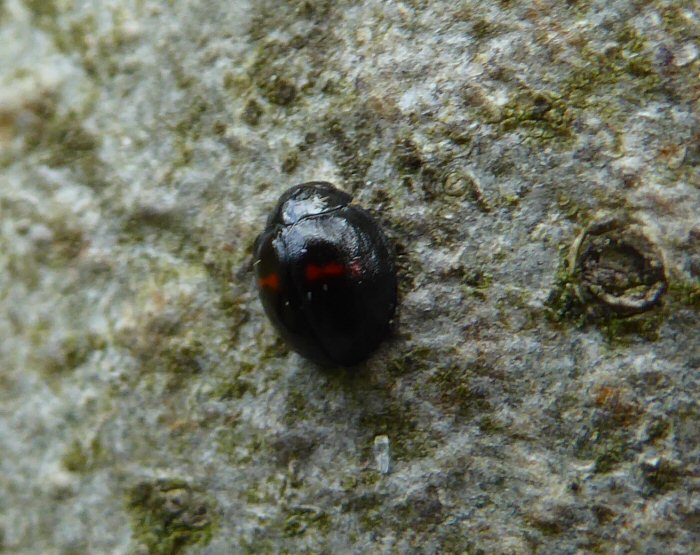
Above the back door of the Field Centre, a large, light coloured moth was sitting quite peacefully. We were able to collect it and ID it as a Broad-bordered Yellow Underwing. It sat quietly whilst its photograph was taken before flying off showing off its bright yellow underwings! This moth emerges in July and aestivates, which means that it lies dormant. It becomes active in August and September.

A Little Habitat
Saturday, September 8th 2018
Walking onto the middle moor, the area between the fence and the ditch was beginning to show signs that fungi were developing. In the ditch some small willow shrubs needed a closer examination.. We were amazed at the finds on them. Sawfly larvae feeding on a willow leaf, took up their defensive positions.

On another stem was a crab spider. On closer inspection we realised that we were interrupting his lunch!

Well camouflaged, was a Common Shield Bug

To finish the blog there are some dates for your diary.
The calendar competition closes on Friday 14th September. The first Winter Worky Day is on Saturday 6th October and the Coffee Morning is on the 8th of November. More details about these and other events can be found on the News and Events page.
Christmas is just on the horizon and the Foxglove Covert Christmas Dinner will be held at Wathgill on Wednesday 12th December.
A Fact-Finding Trip from West Yorkshire
Friday, September 7th 2018
Apart from the conservation of habitats and species at Foxglove being one of the three objectives in managing the reserve, the other two are about research and advancing knowledge about local biodiversity, and promoting and fostering the educational use of the site.
We aim to set examples of good practice in the work that we do, so welcoming 13 members of the Churwell Environmental Volunteers group to the reserve gave us a chance to show how Foxglove has developed and what we are doing now.
The group spent 3 hours here having travelled up from Churwell, near Morley in West Yorkshire. There they are managing and developing their own reserve, so they came to find out examples of what they could do there.
After a short presentation on the development of the reserve, they had a walk around to look at management of access and habitats. Included in this was the use of the metal sheets to attract reptiles and amphibians. This Greater Crested Newt had been found under one of the sheets the previous day.
Having had a good look around, they gathered back in the Activity Room to compare notes. It was clear from the discussion that they had gained a lot from their visit, and they set off to head off back doen the A1 with an invitation to call in and see what they are doing when we are passing.
Machine Store Improvements
Thursday, September 6th 2018
We've talked about it for some time now, but today was the day that we gave the machine store a make over.

It didn't take long for us to get the new brushcutter hanger fixed onto the batons we put up a couple of weeks ago, and then it was onto the main attraction.
These improvements have been long overdue and are coinciding with improvements to how we log hours and maintain our kit; one way in which these two aspects link together is through better storage and labelling of what we have, and what is needed to maintain each and every item.

By the end of the day we were all but complete, with the container now just requiring a few minor adjustments and labelling in order for it to be fully functional.

It may seem boring, but proper storage and maintenance of the kit you have is key to keeping a Reserve like Foxglove running.
Willow Spiling Workshop
Tuesday, September 4th 2018
Today we have been busy Willow Spiling on the banks of a bend in Risedale Beck.

Thankfully we had quite a large group of people in and so got through a whole 10 meter section in a day. Aside from construction of the spiling structure we had a group of people processing branches of a suitable size to make stakes, and another group cutting Willow whips from this year's coppice block to weave between the stakes (as shown in the diagram below).
.png)
Before long we had weaved as much as we could between the stakes and started backfilling the eroded bank on top of hessian membrane, thus keeping the material from washing away whilst also allowing roots to grow through and give extra support to the bank.

On top of all of this we had yet another group carrying out more path works from the Field Centre down to the Scrapes.
The Changing Seasons
Monday, September 3rd 2018
Much was made on Saturday of the 1st September being the start of Autumn in the meteorological calendar and how the weather was going to remain warm and sunny despite this. Today it really does feel like the seasons have moved on and there is definitely an autumnal feel in the air, especially once the rain set in at lunchtime. Despite this, we have had some hardy visitors in today including one lady on her first visit who, despite looking a touch bedraggled, declared that Foxglove is “marvellous!”.
The first signs of Autumn are now starting to show and the Beech trees are turning yellow. Having worked on the north coast of Cornwall for over 10 years, I am still delighted by the changing colours at this time of year in North Yorkshire, as there the winds at this time of year strengthen and most of the leaves disappear from the trees before there is any real time to change colour.
The hot weather of the last few months has clearly had an effect on fruit and the Apple trees at Foxglove are all well laden. The same can be said for Blackberry, Blackthorn and Hawthorn.
As the Swallows are gathering on the old Hawthorn trees near to Plovers Pool, preparing for their migration to South Africa, other trees are also showing signs of changing colour and the Red Oak next to the Field Centre is promising to be very colourful in the near future.
All Done and Dusted!
Sunday, September 2nd 2018
All done and dusted for another year. CES 12 was completed today. In all of the 26 years CES has been running at Foxglove not a day has been missed. Some days, over the years, have been challenging due to the weather conditions but with hard work and commitment the ringers have ensured every session has been completed. Congratulations and a huge thank you to everyone involved.
The nets were opened at 0530 this morning and taken down at 1600. It was a day in part of Great Tits and Blue Tits. Many had been ringed in the nest boxes but surprisingly several were new birds. Adult birds were few, as they are still moulting. Most of the summer migrants have now left and headed south.
Some of the bird ringing team at the end of the session, just before they all sat down for a welcome cup of tea and cake. When the totals were tallied it showed that the day had been 10th equal for CES day 12 over the past 26 years. Looking at the totals for the entire CES season it again showed that 2018 was 10th out of 26 indicating that the year has been just a bit better than average where numbers of birds caught is concerned. Further analysis will be conducted shortly by the BTO staff.
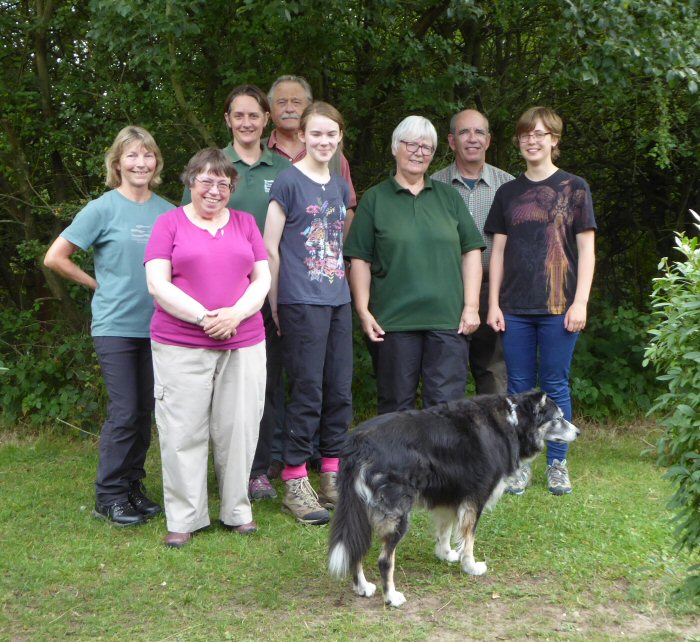
Early this morning a white shape gliding over the moorland proved to be a Barn Owl. One of 'ours' I am sure! John was able to catch this image, from a long distance.

It was also a day of butterflies. They were making the most of the late summer heat and feeding on Hemp Agrimony and Devil's Bit Scabious.
Although I have rather a lot of butterfly photos I am unable to resist taking more. Comma butterflies have a most beautiful wing pattern and edge.

Brimstones were flying too. Can you find where this one is hidden?





.JPG)
.JPG)






.JPG)
.JPG)
.JPG)


